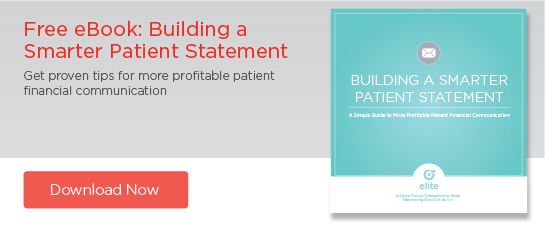Improve Patient Statement Effectiveness with These Eight Simple Metrics
January 25, 2016 •Brian Watson


Without margin, there is no mission.
I’m not a betting man, but I’d wager this isn’t the first time you’ve come across that particular expression.
Shopworn or not, it’s stuck around this long because it neatly describes one of the key challenges of healthcare financial management. The mission of healthcare is to deliver high-quality care to patients in need. But that principle can only be met if the bottom line is healthy enough to keep the doors open and lights on.
No margin, no mission.
In other words, excellent patient care is built on a foundation of prudent financial management. That's particularly true in today’s marketplace, where more regulation, new care models, and growing consumerism are putting even more pressure on profitability.
And that same complex operating environment means that prudent management is also increasingly data-driven. Now more than ever, sound business intelligence is often the best management tool at your disposal for minimizing costs, optimizing revenue opportunities, and predictably controlling profit margins.
Using Metrics to Overcome Paralysis by Analysis
In the words of legendary management guru Peter Drucker, what gets managed gets improved.
But even with all the financial and transactional data that's available to today's revenue cycle leadership, managing analytically can be harder that it might appear.
The typical revenue cycle has a ton of moving parts. And without the right focus, it can be difficult to unpack what’s working in one area from what’s causing issues in another.
Is recent positive momentum in A/R Days a holistic, organization-wide effort? Or can it be traced to a single recent revenue cycle initiative or new patient communication technology?
Readily accessible data is good. Actionable business intelligence is even better.
Revenue cycle Key Performance Indicators are great for helping financial leaders track and improve patient financial performance. But as important as KPIs are in benchmarking and evaluation, they’re not always ideal for drilling down to specific, root-cause issues.
In instances where correlation is key, targeted metrics can help fill in knowledge gaps – providing additional insight that can be used to test and evaluate the success of new processes, improvements, or technologies.
Identifying the Patient Financial Communication Metrics That Matter Most
From a billing perspective, clearly defined metrics add a layer of transparency that helps providers take the guesswork out of financial engagement and improve communication strategies.
Put another way, KPIs provide a critical snapshot of overall revenue cycle health at the macro level. While individual patient financial communication metrics offer drill-down intelligence that identifies what’s working and what could still use additional fine-tuning at the point of financial engagement.
In that sense, PFS metrics act as a kind of canary in the coal mine. First by identifying problems in statement clarity or financial communication before they adversely affect revenue cycle KPIs down the road. Then by providing real-world data that helps allocate resources to areas where they will have the greatest impact.
That’s the argument for using communication-centric financial metrics. But what are some of the most helpful targets? In the rest of this post, I’ll identify eight key metrics that can help providers improve financial performance and take the guesswork out of patient engagement.
Statement Deliverability
((Undeliverable statements + Returned statements) / Total records in statement file)) * 100
What It Tracks:
A high-performing patient financial communication system starts with reliable delivery data. After all, financial correspondence can’t successfully collect from patients if it doesn’t reach them first. Statement deliverability metrics help ensure that data collected during patient access is sound and address cleansing tools are working as anticipated by tracking the percent of undeliverable statements over time.
How It Benefits the Bottom Line:
Statements suppressed due to incomplete or inaccurate address information slows collection activities. And bills that bounce back as return mail are even more harmful – not only decelerating payment but also requiring return mail processing and re-mailings that increase collection costs. Reducing return mail eliminates hidden inefficiencies that can siphon revenue from your bottom line.
Cost to Collect
Total Cash Collected - Total Delivery Cost
What It Tracks:
Assesses the overall profitability of statement print and mail operations.
How It Benefits the Bottom Line:
An increase in collection costs might just be a routine blip – or it could be indicative of larger statement processing or engagement problems. Tracking cost to collect helps providers stay in front of trending issues. In addition, this metric can be used for an apples-to-apples comparison of the profitability of different billing channels – enabling smarter allocation of resources and focus.
Revenue Per Statement
Total Cash Collected / Total Statements Sent
What It Tracks:
Measures how effective billing and payment channels are in collecting from patients.
How It Benefits the Bottom Line:
This simple metric tracks communication efficacy – providing the tools to optimize patient financial correspondence. One ideal use? Conducting statement design experiments and split-tests to see if targeted improvements successfully move the needle on collections.
Average Days to Pay
Statement Date - Payment Date
What It Tracks:
Another snapshot view of statement effectiveness, average days to pay helps correlate patient statements with the amount of time a balance remains outstanding.
How It Benefits the Bottom Line:
Tracks the impact that billing quality has on time-to-pay measures – which directly impacts organizational cash flow. As with the other financial metrics listed above, average days to pay can be used to put teeth to statement upgrades or objectively evaluate channel performance with quantitative data.
Call Center Activity Per Statement
(Call Center Volume / Total Statements Sent) * 100
What It Tracks:
Call center volume as a percent of total statements sent.
How It Benefits the Bottom Line:
Additional call center traffic increases collection costs and taps staff time and productivity. So understanding the relationship between patient statement and service volume is particularly critical. In addition, using total statements sent as a denominator provides a reliable comparison point – no matter overall activity for the period.
Billing and Payment Channel Usage
(Statements delivered per channel / Total statements sent) * 100
(Revenue collected per channel / Total revenue collected) * 100
What It Tracks:
Patient adoption of specific billing channels.
How It Benefits the Bottom Line:
Convincing patients to use emerging, digital billing and payment channels has real monetary benefits for providers – from lower collection costs to fewer payment exceptions. But there’s often a very big cost associated with the technology in the here-and-now.
Having access to channel volume metrics – on both the billing and payment fronts – can help providers evaluate the return on specific technologies. Channel enrollment metrics also support quick, data-driven decisions on how best to engage patients about digital channels – and how much to budget to do so.
The Wrap-Up
You can’t manage what you don’t measure.
Patient billing-focused metrics – like the eight described in this post – help support traditional revenue cycle KPIs, providing the data-driven tools that financial leadership need to proactively identify and manage the root causes of billing and payment performance.
Get Updates
Featured Articles
Categories
- Charity Care Management (1)
- Compliance (2)
- Customer Service (8)
- Digital Front Door (1)
- Direct Mail (6)
- eBilling (1)
- EBPP (34)
- ESL Statement (2)
- eStatement (1)
- Healthcare Channel Partner Billing (1)
- IVR (3)
- Mobile Payment (11)
- Online Billing and Payment (6)
- Online Patient Payment (17)
- Outsource Print Management (4)
- Paperless Billing (4)
- Patient Engagement (2)
- Patient Friendly Billing (21)
- Print and Mail (7)
- QR Codes (1)
- Quick Pay (7)
- Security (1)
- Self-Pay Patients (9)
- Self-Pay Revenue (4)
- Statement Design (32)
- Statement Print and Mail (1)
- Statement Printing and Mailing (28)
- Statement Processing (36)
- TransPromo (1)
- Up-Front Billing (1)


